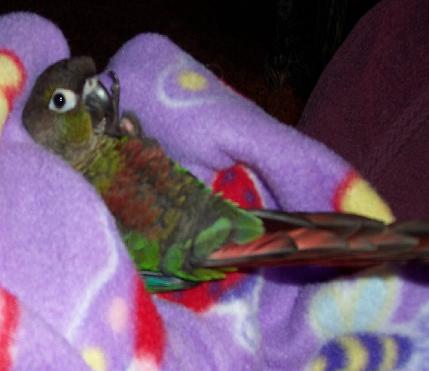

Say, "Aw!"
This is Tator. He is a Green Cheek Conure and is one of our babies. This picture was taken by his new owner, Jackie, around Christmas time 2005.
Green Cheek Conures are a fabulous little parrot. They are not real big, only measuring about 11 inches long and are roughly the size of a cockatiel. They are a perfect apartment parrot! Unlike our Sun Conures, Green Cheek Conures are a quieter bird. I'm not saying that they do not talk or jibber jabber generously and let out a jungle call now and then. I'm saying decimal-wise they can not reach the levels that the Suns can. Some people, such as myself, are just sold on perpetual good nature of the Sun Conures and are willing totolerate the occasionally banshee screeches that our family compares to a nucleur alert. But the Green Cheek Conure stands right beside the Sun as far as personality.
Cuddly and playful, they are always on a mission. Green Cheeks remind me of a Jack Russel Terrier- always moving, always doing something, and doing it with all their heart. And, don't let their size fool you, they can be fierce at times and will let you know with a verbal exchange when you have offended them! They can also get a little nippy and it can hurt, but with gentle, firm handling this can be curbed. We have noticed that our GC babies get nippy right near, or after, weaning and then again when they reach sexual maturity. Like many phases, it comes and goes with little fuss, especially with a single pet. There are techniques for dealing with this nippiness, such as firmly grasping their beak and saying “Don’t Bite.” [See also our article on biting if you have received our information packet when taking a baby home]
Over all, they are a peaceful and friendly bird. We have seen our Green Cheeks enjoy small stuffed animal and cuddling up in a make-shift tent made with a small towel or wash clothes. We are amazed with our Gracie [who is Tator's big sister] and how she has never pooped on the cow with a skirt that she has had since she was very tiny. She keeps it well preened, and sleeps on the cow's lap with a wash cloth draped around them both. [Since the writing of this page, Gracie became a momma in Oct. 2006, but still loves her cow and shares in with her mate Oswald.]
In the wild they can be found in South and Central American, and Mexico. The eat berries, fruit, insects, and other vegetation. The flock together and live in social harmony for the most part.
A Green Cheek Conure will do well in a cockatiel size cage, but as with any bird, the bigger the better. Your Green Cheek will like to come out often and spend time hanging out with you and playing about.
The Green Cheek Conure comes in several color mutations; normal as shown above, yelllow-sided, cinnamon, pineapple, and even turquoise, and splits. We now have our own breeding pair Gracie and Oswald, and are working on setting up a second pair. We have a sweet little pineapple girl named Maggie and she awaits her future groom.
As with any parrot species, it is best to do a good bit of research before and after bringing one into your home. There are up sides and down sides to each specie and it is up to you to decided which is best suited for your home and lifestyle.
CLICK HERE TO RETURN TO OUR HOME PAGE